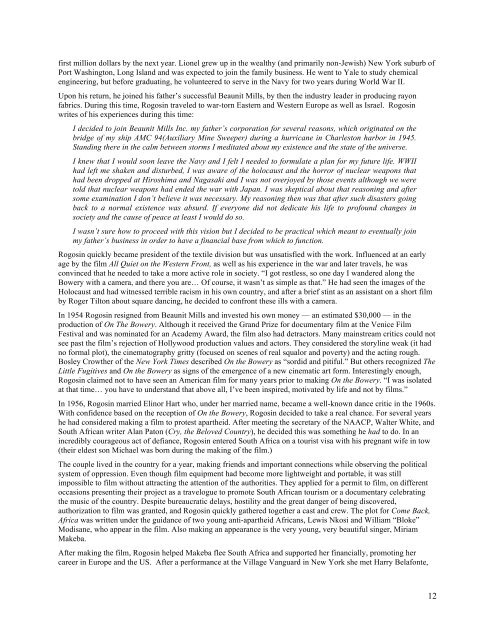Come Back Africa Press Kit - Get a Free Blog
Come Back Africa Press Kit - Get a Free Blog
Come Back Africa Press Kit - Get a Free Blog
You also want an ePaper? Increase the reach of your titles
YUMPU automatically turns print PDFs into web optimized ePapers that Google loves.
first million dollars by the next year. Lionel grew up in the wealthy (and primarily non-Jewish) New York suburb of<br />
Port Washington, Long Island and was expected to join the family business. He went to Yale to study chemical<br />
engineering, but before graduating, he volunteered to serve in the Navy for two years during World War II.<br />
Upon his return, he joined his father’s successful Beaunit Mills, by then the industry leader in producing rayon<br />
fabrics. During this time, Rogosin traveled to war-torn Eastern and Western Europe as well as Israel. Rogosin<br />
writes of his experiences during this time:<br />
I decided to join Beaunit Mills Inc. my father’s corporation for several reasons, which originated on the<br />
bridge of my ship AMC 94(Auxiliary Mine Sweeper) during a hurricane in Charleston harbor in 1945.<br />
Standing there in the calm between storms I meditated about my existence and the state of the universe.<br />
I knew that I would soon leave the Navy and I felt I needed to formulate a plan for my future life. WWII<br />
had left me shaken and disturbed, I was aware of the holocaust and the horror of nuclear weapons that<br />
had been dropped at Hiroshima and Nagasaki and I was not overjoyed by those events although we were<br />
told that nuclear weapons had ended the war with Japan. I was skeptical about that reasoning and after<br />
some examination I don’t believe it was necessary. My reasoning then was that after such disasters going<br />
back to a normal existence was absurd. If everyone did not dedicate his life to profound changes in<br />
society and the cause of peace at least I would do so.<br />
I wasn’t sure how to proceed with this vision but I decided to be practical which meant to eventually join<br />
my father’s business in order to have a financial base from which to function.<br />
Rogosin quickly became president of the textile division but was unsatisfied with the work. Influenced at an early<br />
age by the film All Quiet on the Western Front, as well as his experience in the war and later travels, he was<br />
convinced that he needed to take a more active role in society. “I got restless, so one day I wandered along the<br />
Bowery with a camera, and there you are… Of course, it wasn’t as simple as that.” He had seen the images of the<br />
Holocaust and had witnessed terrible racism in his own country, and after a brief stint as an assistant on a short film<br />
by Roger Tilton about square dancing, he decided to confront these ills with a camera.<br />
In 1954 Rogosin resigned from Beaunit Mills and invested his own money — an estimated $30,000 — in the<br />
production of On The Bowery. Although it received the Grand Prize for documentary film at the Venice Film<br />
Festival and was nominated for an Academy Award, the film also had detractors. Many mainstream critics could not<br />
see past the film’s rejection of Hollywood production values and actors. They considered the storyline weak (it had<br />
no formal plot), the cinematography gritty (focused on scenes of real squalor and poverty) and the acting rough.<br />
Bosley Crowther of the New York Times described On the Bowery as “sordid and pitiful.” But others recognized The<br />
Little Fugitives and On the Bowery as signs of the emergence of a new cinematic art form. Interestingly enough,<br />
Rogosin claimed not to have seen an American film for many years prior to making On the Bowery. “I was isolated<br />
at that time… you have to understand that above all, I’ve been inspired, motivated by life and not by films.”<br />
In 1956, Rogosin married Elinor Hart who, under her married name, became a well-known dance critic in the 1960s.<br />
With confidence based on the reception of On the Bowery, Rogosin decided to take a real chance. For several years<br />
he had considered making a film to protest apartheid. After meeting the secretary of the NAACP, Walter White, and<br />
South <strong>Africa</strong>n writer Alan Paton (Cry, the Beloved Country), he decided this was something he had to do. In an<br />
incredibly courageous act of defiance, Rogosin entered South <strong>Africa</strong> on a tourist visa with his pregnant wife in tow<br />
(their eldest son Michael was born during the making of the film.)<br />
The couple lived in the country for a year, making friends and important connections while observing the political<br />
system of oppression. Even though film equipment had become more lightweight and portable, it was still<br />
impossible to film without attracting the attention of the authorities. They applied for a permit to film, on different<br />
occasions presenting their project as a travelogue to promote South <strong>Africa</strong>n tourism or a documentary celebrating<br />
the music of the country. Despite bureaucratic delays, hostility and the great danger of being discovered,<br />
authorization to film was granted, and Rogosin quickly gathered together a cast and crew. The plot for <strong>Come</strong> <strong>Back</strong>,<br />
<strong>Africa</strong> was written under the guidance of two young anti-apartheid <strong>Africa</strong>ns, Lewis Nkosi and William “Bloke”<br />
Modisane, who appear in the film. Also making an appearance is the very young, very beautiful singer, Miriam<br />
Makeba.<br />
After making the film, Rogosin helped Makeba flee South <strong>Africa</strong> and supported her financially, promoting her<br />
career in Europe and the US. After a performance at the Village Vanguard in New York she met Harry Belafonte,<br />
12


